
(a)
Interpretation:
The complete, detailed mechanism and the major organic product for the given reaction is to be drawn.
Concept introduction:
When
Answer to Problem 18.68P
The complete, detailed mechanism and the major organic product for the given reaction is as shown below:
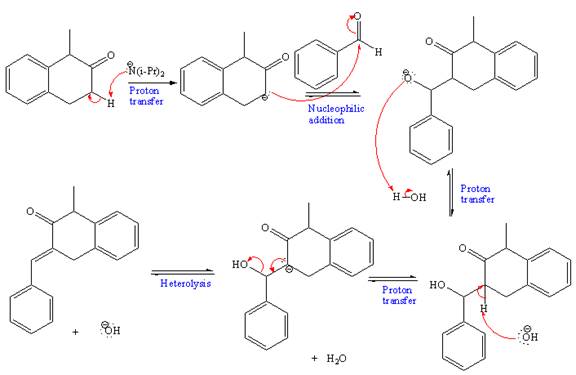
Explanation of Solution
The given reaction is as shown below:
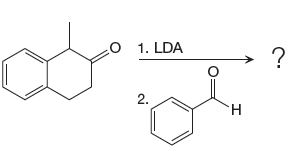
The given reaction is a crossed aldol condensation as the nucleophilic species is generated from a different ketone than the one that is attacked. Firstly, the given ketone is treated with LDA to produce
The complete, detailed mechanism and the major organic product for the given reaction is as shown below:
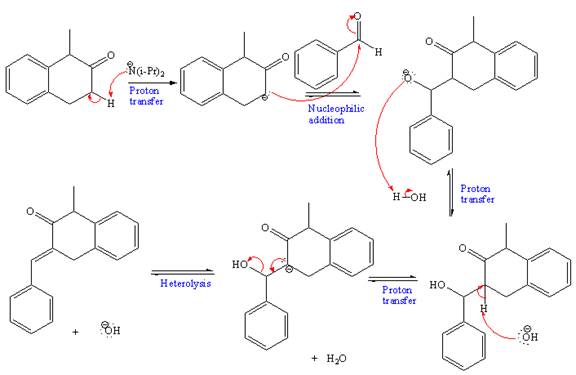
The complete, detailed mechanism and the major organic product for given reaction is drawn by crossed aldol reaction followed by dehydration of
(b)
Interpretation:
The complete, detailed mechanism and the major organic product for given reaction is to be drawn.
Concept introduction:
When ketone is treated with sodium hydroxide, the product
Answer to Problem 18.68P
The complete, detailed mechanism and the major organic product for given reaction is as shown below:
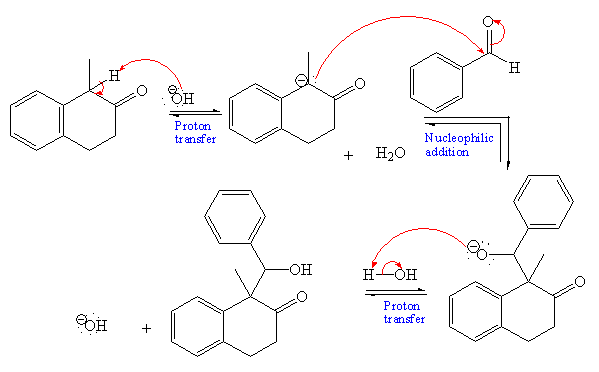
Explanation of Solution
The given reaction is as shown below:
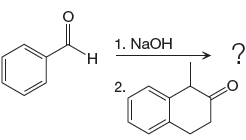
The given reaction is a crossed aldol reaction. In Step 1,

The complete, detailed mechanism and the major organic product for given reaction is drawn on the basis of crossed aldol reaction mechanism.
(c)
Interpretation:
The complete, detailed mechanism and the major organic product for given reaction is to be drawn.
Concept introduction:
When aldehyde is treated with sodium hydroxide, the product
Answer to Problem 18.68P
The complete, detailed mechanism and the major organic product for given reaction is as shown below:
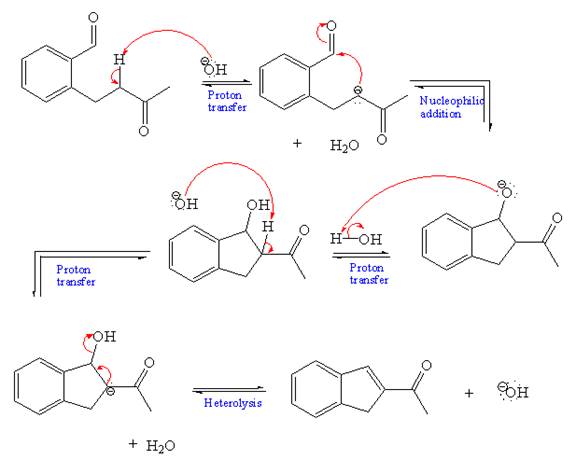
Explanation of Solution
The given reaction is
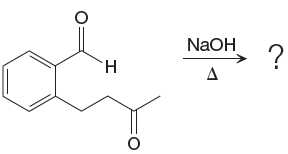
The given reaction is intramolecular aldol condensation reaction as the sodium hydroxide and heat is given. The given aldehyde is treated with sodium hydroxide, to produce
The complete, detailed mechanism and the major organic product for the given reaction is as shown below:

The complete, detailed mechanism and the major organic product for given reaction is drawn on the basis of intramolecular aldol condensation reaction.
(d)
Interpretation:
The complete, detailed mechanism and the major organic product for given reaction is to be drawn.
Concept introduction:
When ketone is treated with strong base like LDA, the product enolate anion is formed. In Step 1, LDA deprotonates the
Answer to Problem 18.68P
The complete, detailed mechanism and the major organic product for given reaction is as shown below,
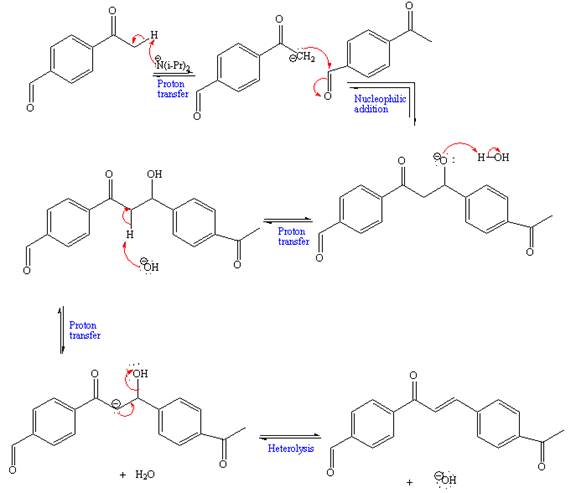
Explanation of Solution
The given reaction is
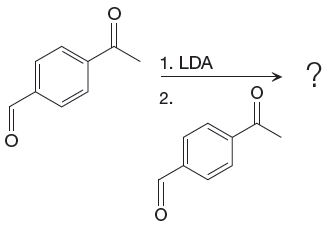
Firstly, the given ketone is treated with LDA, to produce
The complete, detailed mechanism and the major organic product for given reaction is as shown below,

The complete, detailed mechanism and the major organic product for given reaction is drawn by aldol addition reaction followed by dehydration of
Want to see more full solutions like this?
Chapter 18 Solutions
Get Ready for Organic Chemistry
- :0: :0: Select to Add Arrows :0: (CH3)2NH :0: ■ Select to Add Arrows :0: :0: (CH3)2NH ■ Select to Add Arrowsarrow_forwardDraw the product of the following H action sequence. Ignore any inorganic byproducts formed. 1. (CH3CH2)2CuLi, THF 2. CH3Br Q Atoms, Bonds and Rings H Charges ㅁarrow_forwardPlease help me with this the problem is so confusingarrow_forward
- 14 Question (1 point) Disiamylborane adds to a triple bond to give an alkenylborane. Upon oxidation with OH, H2O2, the alkenylborane will form an enol that tautomerizes to an aldehyde. In the first box below, draw the mechanism arrows for the reaction of disiamylborane with the alkyne, and in the last box draw the structure of the aldehyde. 4th attempt Feedback i > 3rd attempt OH, H2O2 i See Periodic Table See Hintarrow_forwardanswer with mechanisms and steps. handwritten please!arrow_forwardHello I need some help with Smartwork. For drawing structure B, I know the correct answer is CH₃B₂, but when I try to type it in, it keeps giving me CH₄BH₃ instead. Do you know how I should write it properly? Should I use a bond or something else?arrow_forward
 ChemistryChemistryISBN:9781305957404Author:Steven S. Zumdahl, Susan A. Zumdahl, Donald J. DeCostePublisher:Cengage Learning
ChemistryChemistryISBN:9781305957404Author:Steven S. Zumdahl, Susan A. Zumdahl, Donald J. DeCostePublisher:Cengage Learning ChemistryChemistryISBN:9781259911156Author:Raymond Chang Dr., Jason Overby ProfessorPublisher:McGraw-Hill Education
ChemistryChemistryISBN:9781259911156Author:Raymond Chang Dr., Jason Overby ProfessorPublisher:McGraw-Hill Education Principles of Instrumental AnalysisChemistryISBN:9781305577213Author:Douglas A. Skoog, F. James Holler, Stanley R. CrouchPublisher:Cengage Learning
Principles of Instrumental AnalysisChemistryISBN:9781305577213Author:Douglas A. Skoog, F. James Holler, Stanley R. CrouchPublisher:Cengage Learning Organic ChemistryChemistryISBN:9780078021558Author:Janice Gorzynski Smith Dr.Publisher:McGraw-Hill Education
Organic ChemistryChemistryISBN:9780078021558Author:Janice Gorzynski Smith Dr.Publisher:McGraw-Hill Education Chemistry: Principles and ReactionsChemistryISBN:9781305079373Author:William L. Masterton, Cecile N. HurleyPublisher:Cengage Learning
Chemistry: Principles and ReactionsChemistryISBN:9781305079373Author:William L. Masterton, Cecile N. HurleyPublisher:Cengage Learning Elementary Principles of Chemical Processes, Bind...ChemistryISBN:9781118431221Author:Richard M. Felder, Ronald W. Rousseau, Lisa G. BullardPublisher:WILEY
Elementary Principles of Chemical Processes, Bind...ChemistryISBN:9781118431221Author:Richard M. Felder, Ronald W. Rousseau, Lisa G. BullardPublisher:WILEY





